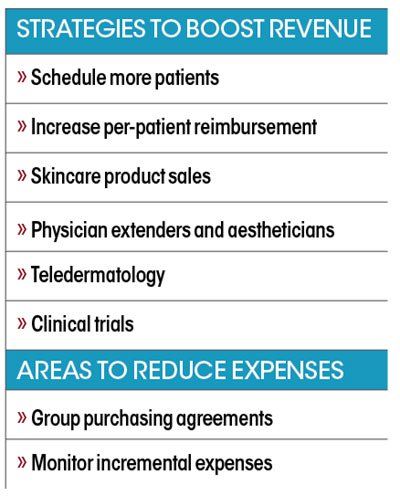- Acne
- Actinic Keratosis
- Aesthetics
- Alopecia
- Atopic Dermatitis
- Buy-and-Bill
- COVID-19
- Case-Based Roundtable
- Chronic Hand Eczema
- Chronic Spontaneous Urticaria
- Drug Watch
- Eczema
- General Dermatology
- Hidradenitis Suppurativa
- Melasma
- NP and PA
- Pediatric Dermatology
- Pigmentary Disorders
- Practice Management
- Precision Medicine and Biologics
- Prurigo Nodularis
- Psoriasis
- Psoriatic Arthritis
- Rare Disease
- Rosacea
- Skin Cancer
- Vitiligo
- Wound Care
Article
Realistic budget is one key to practice success
Author(s):
The purpose of a budget is to help a practice spend less than what it earns. Benchmarking indicates whether a practice is underachieving or overachieving compared to similar businesses. Learn more.
When it comes to financial planning, a realistic budget is key for a dermatologic practice.
“Many of us in practice have zero background in business training,” says Sarah Jackson, M.D., of Audubon Dermatology in New Orleans. “Plus, I think that many dermatologists skip some of the basic things they should be doing - like a budget for financial planning.”
Dr. Jackson points out that a budget is more than spreadsheet, it’s a plan.

“It’s a plan to help you spend less than you earn. When you start, you need to look at real numbers. For an ongoing business, this entails reviewing past numbers and looking for areas of concern. In other words, focus on areas where you think you can spend less and areas where you think you can earn more,” she says.
A budget should allow a practice to have less anxiety and more control over what happens during a calendar year.
“It is not necessarily just about making more money. It may be seeing a different type of patient or having more vacation or making money from a procedure that up to now has been unprofitable,” Dr. Jackson says.
Creating a budget involves being thoughtful about “what you want to do more of and what you want to do less of,” she says.
Dr. Jackson believes that the most efficient step is for an accountant or an office manager to present numbers that make sense to the practice.
Among the key performance indicators (KPIs) that should be reviewed are net collections (net collected revenue divided by adjusted charges), overhead (expenses divided by revenue), accounts receivable, practice income and expense lines.
Practices will vary in these crucial parameters.
“However, there is a healthy range,” Dr. Jackson says. “Watch your trend. When your numbers are out of norm, figure out why.”
Benchmarking is also important to assess whether a practice is underachieving or overachieving compared to similar businesses.
“You frequently need to pay for this data, but it is invaluable to know where you stand and where you realistically might progress,” says Deirdre Hooper, M.D., also of Audubon Dermatology. Drs. Hooper and Jackson spoke on budgeting at an American Academy of Dermatology (AAD) meeting held in July.
“Be sure the benchmarks are similar to your practice in geography, cosmetic mix and size. Then look for outliers that may indicate where you are doing well and where you are doing poorly in comparison to comparable practices,” Dr. Hooper says.
A practice’s income is mainly based on the number of patients seen and the average reimbursement for each of those patients.
“Know your per-procedure costs and your average per-patient income for medical and cosmetic procedures,” she says.
One way to make more money is to schedule more patients. Another way is to increase your average reimbursement per patient.
A third strategy is a passive income growth stream like skin care products sales or using extenders and aestheticians.
“One resource that has been very helpful to us is bringing in a skincare concierge to educate and sell products to patients,” Dr. Hooper says.
ADDED INCOME STREAMS
Teledermatology and clinical trials are two other potential income streams.
Conversely, practice expenses can be reduced by participating in group purchasing agreements for medical supplies. In addition, “everything is negotiable,” Dr. Jackson says. Expenses for information technology (IT), liquid nitrogen and biohazard removal have been reduced at the practice, simply by having a negotiating meeting.
Small deductions can add up, such as kitchen expenses at Audubon Dermatology, where the monthly grocery purchases tripled from one year to the next.
“Placing a limit on grocery expenses and asking employees to submit receipts have kept that number reasonable,” she says.
Look at the budget regularly and be flexible.
“Looking at our goals every month with a projection as to whether we are on track to meet the goal allows us to be flexible,” Dr. Hooper says. “For example, we can ramp up social media or run a special on a device that is not meeting expectations.”
And, finally, if expenses rise, make sure its worthwhile, she adds.
“Remember, it’s not what you make, it’s what you keep,” Dr. Hooper says.
REFERENCES
1. Weissinger SE, Keil P, Silvers DN, et al. A diagnostic algorithm to distinguish desmoplastic from spindle cell melanoma. Mod Pathol. 2014; 27:524-34.
2. Wiesner T, Kiuru M, Scott SN, et al. NF1 mutations are common in desmoplastic melanoma. Am J Surg Pathol. 2015; 39:1357-62.
Newsletter
Like what you’re reading? Subscribe to Dermatology Times for weekly updates on therapies, innovations, and real-world practice tips.
















